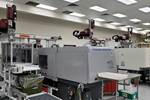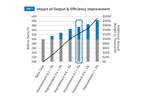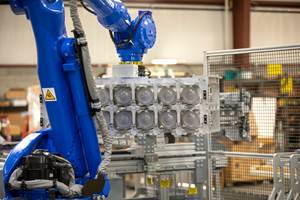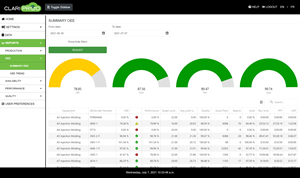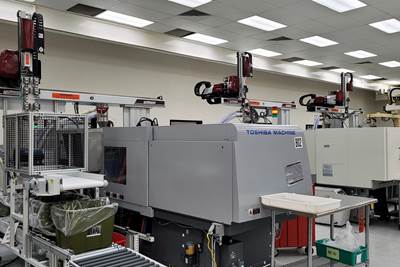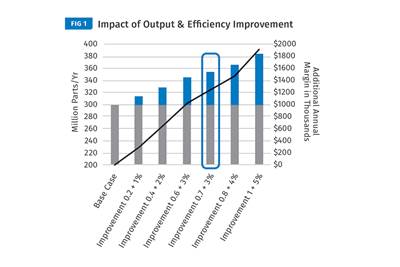Automation and robotics are becoming increasingly important for plastics processors. Faced with labor shortages, manufacturers can gain a crucial productivity margin from automating certain processes. Robotic automation can also help to make the workplace more people-friendly and attractive to the existing and potential workforce.
Indeed, studies show companies that adopt robotics grow faster than those that don't. Unfortunately, many businesses are in a position to benefit from robotics but are unaware of where to start.
Larger plastics processing companies have used robotics for many years, especially for machine tending. The larger companies had higher production volumes, making the ROI attractive. Smaller processing operations, on the other hand, have been slower to adopt robotics because their lower volumes and higher variability in job characteristics have presented a challenge to the technology.
Today, however, the prices of many kinds of robotic solutions have decreased significantly. Automation is more accessible than ever, regardless of the size of the operation, and the number and ways robotics can be applied have expanded.
A Structured Process to Adopting Automation
That said, there remain many areas still ripe for automating. Identifying the best opportunities for robotic automation at the outset is crucial to maximizing your return on investment.
Many manufacturers struggle with where exactly to begin automating. It can be a daunting task, determining where to begin. It starts with understanding your needs. What is your current productivity? How many person-hours are needed to complete the relevant tasks that make up your manufacturing process?
Identifying the best opportunities for robotic automation at the outset is crucial to maximizing your return on investment.
The best place to start is to take a top-down approach to mapping out your factory, looking for those areas that could benefit the most from automation and where the most significant risks lie.
With these ideas in mind, we’ve compiled seven processes often overlooked by plastics manufacturers that are ripe for automation.
1. Raw Material Intake
For processors who don’t buy railcar quantities, resins and additives typically arrive in sacks of varying sizes stacked on pallets. Workers must unload the truck at the dock and convey the pallets to a staging area. Currently, automating the truck-unloading process may be more difficult for robotics, although some excellent systems are on the market. The ideal candidate for automated truck unloading is in a setting with a low variability in the pallet size, shape, and weight. Special considerations apply to the trucks and the docks for this automation to succeed.
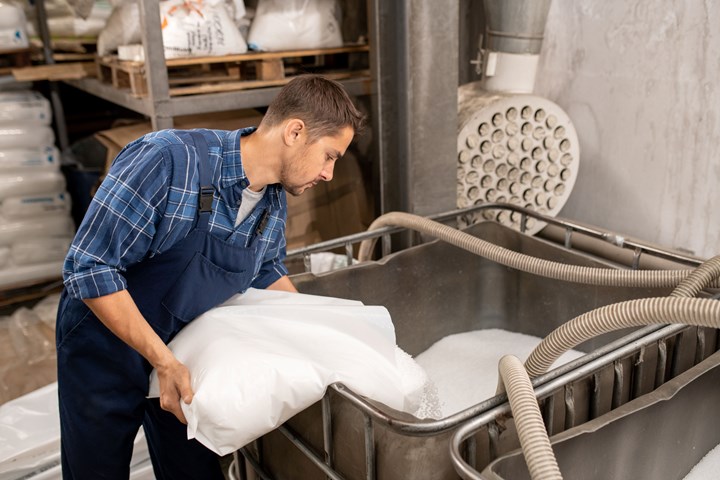
Most processors still rely heavily on operators to move materials around their plant. (Photos: Gain & Co.)
On the other hand, emptying raw-material sacks into a centralized feed system is a task well suited for a robot. Most operations today do this kind of task manually. The worker cuts open the sack, hoists it into a bin, and empties the pellets from the bag into the feed system. The hoisting process may require a gantry or crane if the sacks are larger and heavier.
In emptying the sack, dust is generated that can be problematic for the workers, and injuries from utility blades are sadly relatively common.
Robotics can readily automate the jobs of opening the sacks and emptying them into the appropriate receptacles. Automation reduces labor requirements and protects people from unwanted exposure to dust and particles.
2. Machine Tending
Machine tending is not an overlooked task—indeed, it is probably the most common application for robotics by processors. However, smaller operations may have felt the investment was too significant, the variety of products to be handled was too great, and the complexity of the robot programming too high to be a good match for their organization.
Advancing technology has removed those barriers. The cost of robotics has been reduced dramatically over the last decade. The level of artificial intelligence (AI) has improved significantly, allowing a robot manipulator to handle much more variation than ever before. Also, programming the newer category of collaborative robots, or cobots, can be as easy as grabbing hold of the robot arm and moving it into position. By manually placing a robot arm in a sequences of poses, the robot can be taught the motions to make. No programming is required.
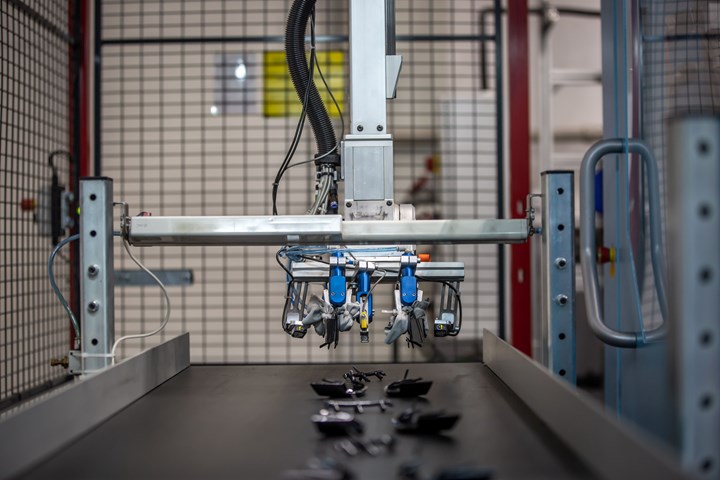
Robots have been deployed for years to remove parts from presses. But falling prices and easier programming make this an option that now even smaller molders can consider.
Thus, machine tending is a form of automation that even small operations can adopt, thanks to falling costs. The most common robot used for machine tending in injection molding applications is the XYZ or Cartesian type. Because such a robot is relatively simple, it is less expensive. If the application requires, an articulated robot arm can perform more complex movements.
3. Deburring and Excess Material Removal
After a plastic part has been removed from a mold, excess material will frequently need to be removed. A rotating saw blade, snipper or grinder/sander are often used for deflashing and deburring.
These are repetitive processes that lend themselves well to automation by robotics. The same robot arm that removes parts from the mold can also perform deflashing and deburring in many applications. Alternatively, one robot can be used for machine tending and part removal, and a different robot can be utilized to do the deburring.

One step that is still manual—and perhaps ripe for automation—is deburring/deflashing.
4. Assembly
Molders may include assembly operations to add value to the part. Assembly processes can enhance the value of your company's services and increase profitability. The assembly task may involve joining plastic parts together or adding metal, rubber or other components to the plastic part to make a larger assembly. Assembly operations are readily automated with robotics. Delta-type robots can be used for rapid pick-and-place, and SCARA robots are often used for small-parts assembly.
5. Inspection
Computer vision technology and AI have made rapid advances in recent years. As a result, visual inspections that were once exclusively the domain of manual processes can now be automated. A typical application is to verify that excess material has been sufficiently or properly removed. Blow molding, for instance, is ripe for automated inspection. Computer vision can handle such inspection with high accuracy and repeatability.
Manual vision inspection, in contrast, is much less accurate. In his Quality Handbook, Joseph Juran, a pioneer in quality assurance, argues that 100% manual visual inspection can be expected to be no more than 87% accurate. Conversely, the accuracy of a properly installed computer-vision inspection system can approach 100%. Computer-vision systems never grow tired or become distracted, both significant factors limiting the accuracy of manual visual inspection.
Computer-vision inspection can also measure dimensions and compare shapes (such as concentricity or ovality) to a predefined standard. Because a camera can take 100 frames or more per second, a robotic system can automatically detect and remove defects at rates that humans cannot match. No human would be reasonably expected to reliably spot defects in a rapidly moving conveyor system. Yet computer-vision inspection can do this quite readily. Examples relevant to processors include detecting cracks and verifying that labels or codes are properly applied.
Computer-vision systems never grow tired or become distracted, both significant factors limiting the accuracy of manual visual inspection.
We have seen cases where there is a reluctance to use computer-vision inspection. For example, sometimes the specifications call for manual visual inspection in surgical or medical applications. Therefore, the manufacturer is reluctant to propose something different. Given the greater accuracy and reliability of computer-vision inspection, it is only a matter of time before such obstacles fade away.
6. Packaging & Palletizing
After removal from the machine, secondary operations and inspection, parts need to be placed into primary packaging, and robotics is an excellent solution. When using robotics for this task, speed, repeatability and accuracy are all superior to manual processes. In addition to placing parts into packages, the packaging itself can be formed by automated systems.
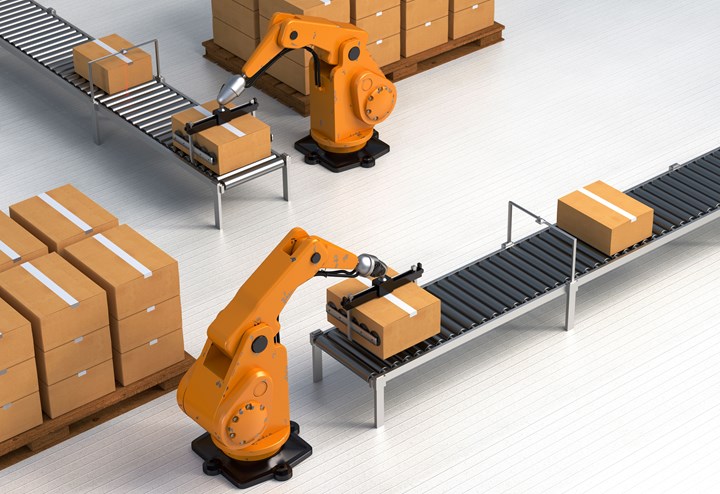 When using robotics for packaging and palletizing, speed, repeatability and accuracy are all superior to manual processes.
When using robotics for packaging and palletizing, speed, repeatability and accuracy are all superior to manual processes.
Placing primary packaging into secondary packages for shipping is also a prime candidate for robots. Once the parts have been properly placed into the secondary packaging, these units can be assembled robotically into pallets for placing onto trucks.
7. Internal Logistics
Another area ripe for automation is the transportation of packages and pallets within a facility. Plastic parts manufacturers can use Automated Guided Vehicles (AGVs) and Autonomous Mobile Robots (AMRs) for such transport.

Automatic guided vehicles can move goods from a primary packaging to a secondary packaging station. On the intake side, such self-driving vehicles can transport incoming pallets to a decanting station.
One typical workflow that AGVs and AMRs can help with is transporting pallets of goods from a palletizing station to the shipping dock. If appropriate, the autonomous robots can move goods from a primary packaging to a secondary packaging station. On the intake side, such self-driving vehicles can transport incoming pallets to a decanting station.
Automation is Within Reach
While not every process is appropriate for automation, the rapid advancement of robotics is allowing a much wider array of businesses access to this technology. Plastics processors are poised to reap the benefits of the future of robotics, and thankfully it’s no longer just large corporations able to take advantage. Small and medium-sized businesses are now able to leverage the increased productivity, heightened safety and insulation against labor shortages that can be derived from automation.
ABOUT THE AUTHOR: Niels Korsager is a senior production and automation advisor at Gain & Co and sister company HowToRobot, both Danish-based independent consultancies on robotics and automation. Korsager previously was Assistant Professor in Supply Chain Manufacturing & Robots at the University of Southern Denmark Since 2017, Gain & Co has been helping companies figure out their robot potential, analyze their business cases and find the right suppliers for their needs. HowToRobot is a matchmaking platform that connects buyers of robotics to the world’s largest network of suppliers. Contact: info@gainco.dk; howtorobot.com.
Related Content
An Automation 'First' for Non-Servo-Eject Trim Presses
Compact, flexible and configurable robotic system is said to be the first to enable thermoformers to fully automate product handling after a non-servo trim press.
Read More50 Years of Headlines … Almost
I was lucky to get an early look at many of the past half-century’s exciting developments in plastics. Here’s a selection.
Read MoreReal-Time Production Monitoring as Automation
As an injection molder, Windmill Plastics sought an economical production monitoring system that could help it keep tabs on its shop floor. It’s now selling the “very focused” digital supervisor it created, automating many formerly manual tasks.
Read MoreEnsuring Repeatability: The Key to Effective Injection Molding Automation
One of automation’s key promises is repeatability: the same movement to the same location, time and time again. But to achieve that, all elements involved — robot, machine, EOAT, mold — must be in and stay in alignment.
Read MoreRead Next
How COVID-19 Did (and Didn’t) Change Automation in Plastics
The global pandemic invigorated longstanding trends and new market forces to push broad-based adoption of automation and robotics from the incremental to the inexorable.
Read MoreWhat to Look for in High-Speed Automation for Pipette Production
Automation is a must have for molders of pipettes. Make sure your supplier provides assurances of throughput and output, manpower utilization, floorspace consumption and payback period.
Read More

